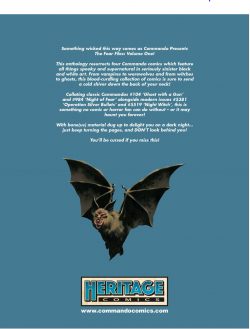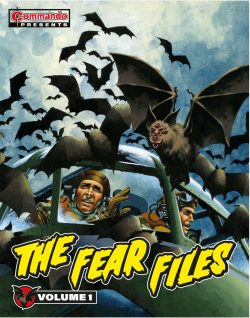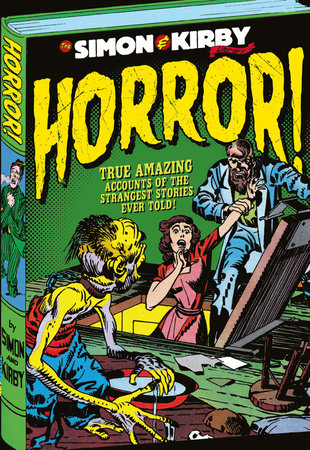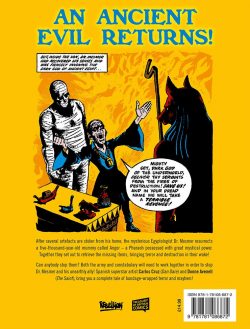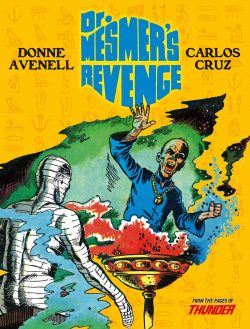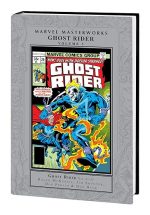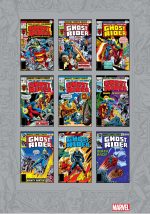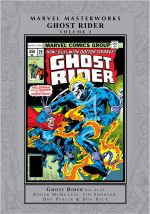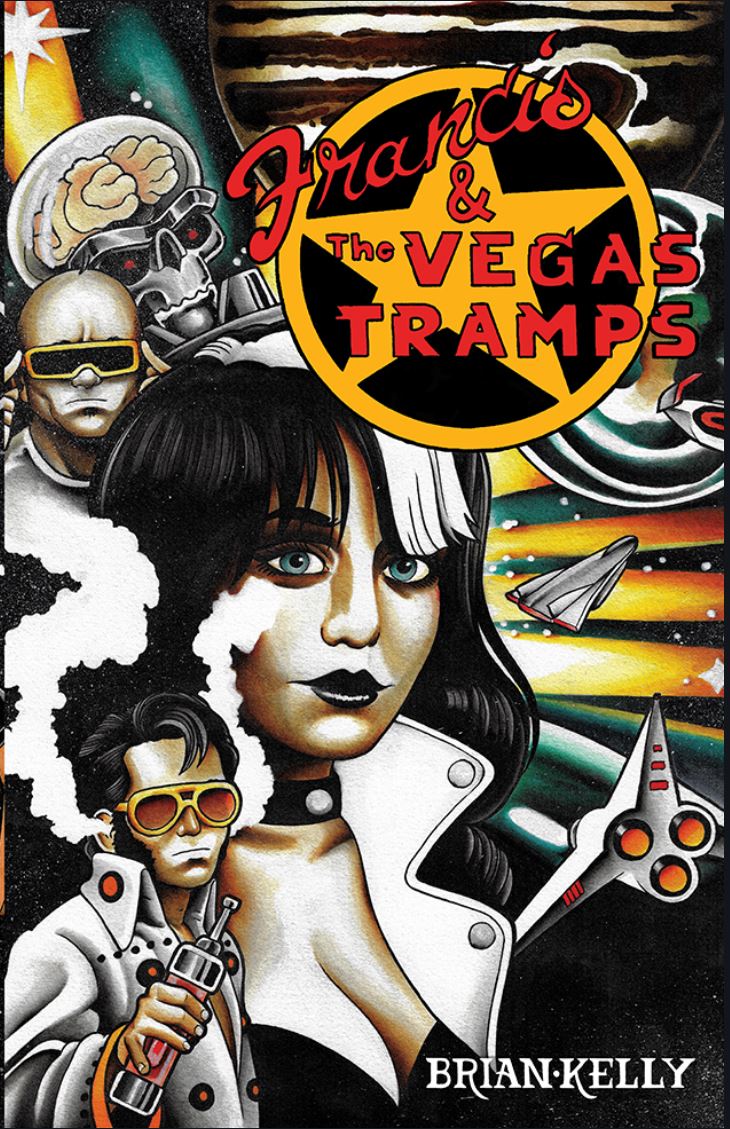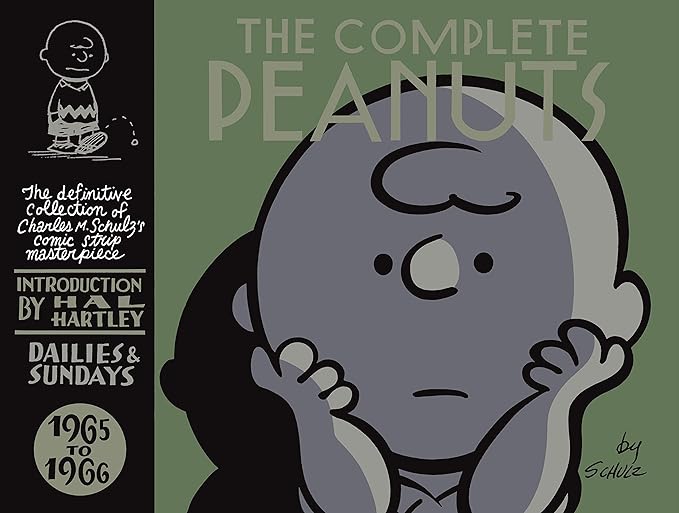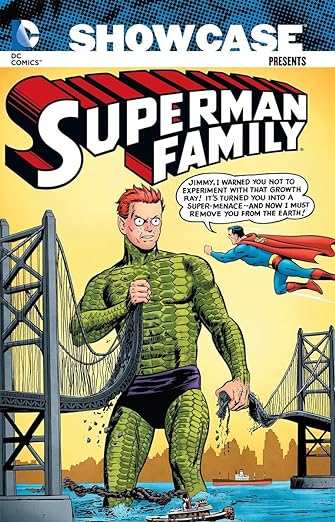
By Otto Binder, Robert Bernstein, Jerry Siegel, Edmond Hamilton, Leo Dorfman, Curt Swan, Kurt Schaffenberger, Al Plastino & various (DC Comics)
ISBN: 978-1-4012-3837-7 (TPB)
When the Man of Steel debuted in Action Comics #1 (cover-dated June 1938) he was instantly the centre of attention, but even then the need for a solid supporting cast was apparent and cleverly catered for. Glamorous daredevil reporter Lois Lane premiered right beside Clark Kent and was a constant companion and foil from the outset, and – although unnamed – a plucky red-headed, befreckled kid started working alongside Lois & Clark from issue #6 (November 1938) onwards.
His first name was disclosed in Superman #13 (November-December 1941) having already been revealed as Jimmy Olsen to radio listeners when he became a major player in The Adventures of Superman show from its debut on April 15th 1940. As somebody the same age as the target audience, on hand for the hero to explain stuff to (all for the listener’s benefit) Jimmy was the closest thing to a sidekick the Action Ace ever needed. He’s remained a sporadic and amazingly popular one ever since.
When the similarly titled television show launched in the autumn of 1952 it was again an overnight sensation and National Periodical Publications began cautiously expanding their revitalised franchise with new characters and titles.
First to get a promotion to solo-star status was the Daily Planet’s impetuously capable if naive “cub reporter”. His addictively charming, light-hearted, semi-solo escapades began in Superman’s Pal Jimmy Olsen #1 (September-October 1954); the first spin-off star in the Caped Kryptonian’s ever-expanding entourage.
It took three years for the cautious Editors to tentatively extend the franchise again. In 1957, just as the Silver Age of Comics was getting underway, try-out title Showcase – which had already launched The Flash in #4 and Challengers of the Unknown in #6 – followed up with a brace of issues entitled Superman’s Girl Friend Lois Lane (#9-10). The “plucky News-hen” was rapidly awarded a series of her own. Technically it was her second, since for a period in the 1940s she had held a regular solo-spot in Superman.
In previous reviews I’ve banged on about the strangely patronising, parochial – and to at least some of us – potentially offensive portrayals of kids and most especially women during this period, and although at least fairer and more affirmative instances were beginning to appear, the warnings still bear repeating.
At that time Lois Lane was one of precious few titles with a female lead, and, in the context of today, one that causes many 21st century fans a few understandable qualms of conscience. Within the confines of her series the valiant, capable working woman careered crazily from man-hungry, unscrupulous bitch through ditzy simpleton to indomitable and brilliant heroine – often all in the same issue. The title was clearly intended to appeal to the family demographic that made I Love Lucy a national phenomenon, and many stories were played for laughs in the same patriarchal, parochial manner: a “gosh, aren’t ladies funny?” tone that appals me today – but not as much as the fact that I still love them to bits. That they’re mostly sublimely illustrated by the wonderfully whimsical Kurt Schaffenberger softens the repeated blows, but really, I should know better…
For the Superman Family and extended cast the tone of the times dictated a highly strictured code of conduct and parameters: Daily Planet Editor Perry White was a stern, shouty elder statesman with a heart of gold, Cub Reporter Jimmy was a brave and impulsive unseasoned fool – with a heart of gold – and Lois was brash, nosy, impetuous and unscrupulous in her obsession to marry Superman, although she too was – deep down – another possessor of an Auric aorta. There were also more people with blue or green skin than brown or other human shades, but as I’m trying to plug this book’s virtues I’m just shutting up now.
Somehow, even with these mandates in place the talented writers and artists assigned to detail their wholesomely uncanny exploits managed to craft tales both beguiling and breathtakingly memorable… and usually as funny as they were thrilling.
By today’s standards, Superman’s Pal Jimmy Olsen wasn’t quite as contentious, but still far too often stories meant to amuse portrayed the bright, bold boy in socially demeaning – if not downright cruel – situations and humiliating physical transformations. Even so, a winning blend of slapstick adventure, action, fantasy and science fiction (in the gentle but insidiously charming manner scripter Otto Binder had perfected 15 years previously at Fawcett Comics on the magnificent Captain Marvel) made the series one of the most popular of the era.
Again, originally most yarns were played for laughs in a father-knows-best manner and tone which can again appal me today, even though I still count them amongst some of my very favourite comics.
Confusing, ain’t it?
This fourth intriguingly intermingled, chronologically complete compendium collects the affable, all-ages tales from Superman’s Girlfriend, Lois Lane #17-26, (spanning May 1960-July 1961) and Superman’s Pal Jimmy Olsen #45-53 (ditto for June 1960-June 1961): a period of infinite wackiness and outrageous absurdity, which also saw the inevitable dawning of a far more serious milieu for the Man of Tomorrow and his human family.
This particular monochrome ethical conundrum commences with the Action Ace’s perpetual lady-in-waiting as SGLL #17 as Robert Bernstein & Schaffenberger introduce ‘The Girl that Almost Married Clark Kent!’, revealing how Lois covertly helps heiress Doris Drake win her reporter partner’s affections, unaware that the conniving rich girl has proof of the Caped Kryptonian’s secret identity…
‘Lana Lang, Superwoman!’ (Jerry Siegel, Curt Swan & Stan Kaye) then sees jealousy run wild as Superman gives first one then the other lady in his life superpowers: a secret scheme to foil Brainiac with no thought as to how either woman will feel once the crisis is over.
The issue ends with Binder & Schaffenberger’s ‘How Lois Lane Got Her Job’, disclosing how, even before she first met him, Superman was inadvertently helping the neophyte journalist score scoops…
SPJ #45, (illustrated throughout by Swan & John Forte) kicked off with Binder-scripted ‘Tom Baker, Power Lad!’: a sharp yarn wherein an apparently ordinary boy temporarily gains super powers. The shocking truth involves then-top-secret weapon Supergirl and the Bottle City of Kandor. Meddling with resident crackpot genius Professor Phineas Potter’s untested time machine hurls Jimmy back to the Wild West where he becomes accidental outlaw ‘The Gunsmoke Kid!’ (by a sadly anonymous scripter) whilst Bernstein’s ‘The Animal Master of Metropolis!’ portrays Jimmy as a local hero and target of crooked gamblers after he starts playing with a magic wand bestowing absolute mastery of the world’s fauna.
Lois Lane #18 opened with ‘The Star Reporter of Metropolis!’ (possibly Binder or Bernstein, but definitely limned by Schaffenberger) wherein a mousy protégé steals Lois’ thunder for the best possible reasons, whilst ‘The Sleeping Doom’ (Bernstein & Schaffenberger) is a superb thriller of aliens invading Earth by taking over people as they fall asleep. Valiant Lois staves off slumber for days until Superman returns to send the invaders packing, before ‘Lois Lane Weds Astounding Man!’ (Binder & Al Plastino), finds the flabbergasted journalist wooed by an alien wonder warrior with a very strange secret…
Another all-Swan & Forte art-extravaganza, Jimmy Olsen #46 opens with Siegel’s ‘Jimmy Olsen, Orphan!’ as an accident gives the cub reporter amnesia and he ends up in the same institution where Linda Lee is hiding whilst learning how to be a Supergirl. Bernstein then hilariously lampoons Hollywood as a succession of starlets romance the baffled but willing lad in ‘The Irresistible Jimmy Olsen!’. Of course, these eager actresses are all operating on the mistaken assumption that our boy is Tinseltown’s latest genius Movie Producer…
The issue concludes with another outing for Jimmy’s occasional alter ego in ‘Elastic Lad’s Greatest Feats!’ with scripter Binder perfectly blending drama and comedy to deliver a punishing moral to the over-impulsive kid.
LL #19 (August 1960 and fully illustrated by Schaffenberger) opens with Bernstein’s ‘The Day Lois Lane Forgot Superman!’ as devoted sister Lucy convinces her perennially heartbroken elder sibling to try hypnosis and get over her destructive obsession. Of course, when it works, Lois finds time to pester Clark so much he has no time to save the world…
When an accident seemingly catapults Lois into the past she quickly becomes enamoured of Samson, a hero with a secret identity as ‘The Superman of the Past!’: a quirky yarn by Binder, before Jerry Siegel debuts a new occasional series.
‘Mr. and Mrs. Clark (Superman) Kent!’ was the first tale of a poignant comedy feature depicting the laughter and tears that might result if Lois secretly married the Man of Steel. Although seemingly having achieved her heart’s desire, she is officially only married to dull, safe Clark and must keep her relationship with the Man of Tomorrow quiet. She can’t brag or show pride and has to swallow the rage she feels whenever another woman throws herself at the still eligible bachelor Superman…
For an artefact of an era uncomfortably dismissive of women, there’s actually a lot of genuine heart and understanding in this tale and a minimum of snide sniping about “silly, empty-headed girls”. Perhaps it was the influence of the tailored-for-adults Superman newspaper strip leaking into the funnybook line….
SPJO #47 sees Jimmy in over his head impersonating an escaped convict Winky McCoy and trapped as ‘The King of Crime! in a cracking suspense tale by Bernstein, Swan & Forte, and the impatiently under-age lad transforms into a husky 30-something thanks to another Prof. Potter potion in ‘Jimmy Grows Up!’ Binder sagely proves that maturity isn’t everything, before Siegel wraps up the issue with a thrilling romp as alien producers of horror movies starring Superman and Jimmy return seeking sequels. Their robot reporter doesn’t like the prospect of being junked at shooting’s end, however, and tries to replace the original in ‘The Monsters from Earth!’…
SGLL #20 (October 1960) opens whimsically with ‘Superman’s Flight from Lois Lane’ (Siegel & Schaffenberger), with the Man of Steel escaping into his own past to see if a different life-path might result in a civilian existence unencumbered by a nosy snooping female. “Disc jockey” Clark soon realises his inquisitive assistant Liza Landis makes Miss Lane look positively disinterested and gladly ends the experiment, after which ‘The Luckiest Girl in Metropolis!’ (Bernstein & Plastino) sees Lois targeted by a Machiavellian mobster seeking to destroy her credibility as a witness, before ‘Lois Lane’s Super-Daughter!’ by Siegel & Schaffenberger revisits the Imaginary Mr. & Mrs. scenario wherein their attempts to adopt Linda (Supergirl) Lee lead to heartbreak and disaster…
That month in all-Swan & Forte Jimmy Olsen #48, anonymously scripted ‘The Story of Camp Superman!’ presents a heart-warming mystery as the cub works as counsellor to a bunch of youngsters – one of whom knows entirely too much about Superman – before ‘The Disguises of Danger!’ reprises undercover Jimmy’s acting abilities to get close to a cunning crook. Binder’s ‘The Mystery of the Tiny Supermen!’ then has Kandor’s miniscule Superman Emergency Squad repeatedly harass Jimmy: a clandestine scheme to stop him accidentally exposing the Man of Steel’s civilian identity…
The all-Schaffenberger November 1960 Lois Lane (#21) offers a double-length epic by author unknown wherein the Anti-Superman Gang utilise explosive toys to endanger the reporter in ‘The Lois Lane Doll!’ forcing the Action Ace to hide her in his Fortress of Solitude. When even that proves insufficient she finds refuge – and unlikely romance – ‘Trapped in Kandor!’ Siegel then scripts a classic comic yarn as bitter rivals gain incredible abilities from a magic lake and duke it out like men in ‘The Battle Between Super-Lois and Super-Lana!’
Cover dated December 1960, Superman’s Pal Jimmy Olsen #49 begins with ‘Jimmy’s Gorilla Identity!’ as the luckless lad meets DC stalwart Congo Bill and gets his personality trapped in the hunter’s occasional alter ego, giant golden ape Congorilla. Next, Professor Potter is blamed for, but entirely innocent of, turning the cub reporter into ‘The Fat Boy of Metropolis!’ in a daft but clever crime caper prior to Siegel playing with contemporary trends as Jimmy impersonates a rock ‘n’ roll star to impress Lucy Lane in ‘Alias, Chip O’Doole!’…
Another all-Schaffenberger affair, LL #22 (January 1961), starts with a Red Kryptonite experiment afflicting the Man of Steel with a compulsion to repeatedly pop the question to an increasingly dubious and suspicious Lois on ‘The Day When Superman Proposed!’ (Binder), after which Bernstein’s ‘Lois Lane’s X-Ray Vision!’ sees irradiated sunglasses create a tidal wave of problems for the Metropolis Marvel, whilst in ‘Sweetheart of Robin Hood!’ another time-shift dream sees Lois courted by a very familiar-seeming Defender of Truth, Justice and the Nottinghamshire Way…
In SPJO #50, Siegel, Swan & Sheldon Moldoff’s ‘The Lord of Olsen Castle’ sees Jimmy as potential heir of a Swedish castle and title. All he has to do is accomplish a slew of fantastic feats and defeat an ogre, utterly unaware Superman and a host of Kryptonians are secretly pitching in. ‘The Weirdest Asteroid in Space’ (Binder, Swan & Moldoff) then offers a bold monster mystery before another Potter experiment shifts all Superman’s might into his teen pal in ‘The Super-Life of Jimmy Olsen!’ by an unknown author illustrated by Al Plastino.
Lois Lane #23 (February 1961) opens with Binder & Schaffenberger’s riotous romp ‘The 10 Feats of Elastic Lass!’ as our impetuous reporter borrows Jimmy’s stretching serum to track down mad bomber The Wrecker, whilst ‘The Curse of Lena Thorul!’ (Siegel) exposes a bewitching beauty’s incredible connection to Lex Luthor before another Seigel Imaginary visit to a possible future sees ‘The Wife of Superman!’ worn to a frazzle by twin super-toddlers and yearning for her old job at the Daily Planet…
March 1961’s Jimmy Olsen #51 reveals ‘Jimmy Olsen’s 1000th Scoop!’ (Bernstein, Swan & Forte), with the prospective milestone repeatedly delayed by Superman for the best possible reasons, after which a sultry alien takes an unlikely shine to the lad. Sadly, ‘The Girl with Green Hair’ (Binder, Swan & Forte) was the result of a scheme by a well-meaning third party to get Lucy to be nicer to Jimmy and it all goes painfully, horribly wrong…
The issue ends with ‘The Dream Detective!’ (Swan & Kaye) as the cub reporter inexplicably develops psychometric abilities and unravels mysteries in his sleep, whilst in Lois Lane #24 (April 1961) anonymously scripted ‘The Super-Surprise!’ sees Lois undercover as a platinum blonde, scuppering a deadly plot against the Superman, superbly linmed by Schaffenberger, as is Bernstein’s ‘The Perfect Husband!’, wherein a TV dating show led Lois into a doomed affair with a he-man hunk who was almost the spitting image of Clark Kent… almost…
The issue closes on Bernstein & Forte’s ‘Lois Lane… Traitor!’ with Lois in the frame for murdering the King of Pahla until the incredible, unbelievable true culprit comes forward…
Also available that April, Superman’s Pal Jimmy Olsen #52 featured Leo Dorfman, Swan & Kaye’s ‘The Specter of the Haunted House!’ as a gang of cunning thieves use supernatural sceptic Olsen as a patsy for a bold robbery scheme, before ‘The Perils of Jimmy Olsen!’ -illustrated by Swan & Forte – sees the laid-up apprentice journo employ a robot double to perform feats of escalating daring and stupidity. ‘Jimmy Olsen, Wolfman!’ (Siegel, Swan & Kaye) then delivers a welcome sequel to the original hit tale wherein Superman’s Pal is again afflicted by lycanthropy thanks to the pranks of other-dimensional imp Mr. Mxyzptlk…
In Lois Lane #25 (May 1961) Siegel & Schaffenberger’s Imaginary series reaches an impressively bittersweet high point in ‘Lois Lane and Superman, Newlyweds!’ as she convinces hubby to announce their relationship to the world and must live with the shocking consequences…
The brilliant reporter side was then highlighted in Bernstein’s diabolical thriller ‘Lois Lane’s Darkest Secret!’ with the daring reporter risking her life to draw out and capture a mesmeric master criminal before ‘The Three Lives of Lois Lane!’ (uncredited with Forte illustrating) sees the journalist surviving a car crash, only to be subsumed into the personalities of dead historical figures Florence Nightingale, Betsy Ross and Queen Isabella of Spain. Here, Superman can only stay near and try to limit the damage…
SPJO #53 opens with ‘The Boy in the Bottle!’ (Siegel, Swan & Kaye) as the cub suffers future shock whilst trapped in Kandor, after which sheer medical mischance results in Siegel, Swan & Forte’s now-legendary saga of ‘The Giant Turtle Man!’ and an oddly casualty-free monster rampage before ‘The Black Magician!’ (unknown writer, Swan & Forte) reveals Jimmy banished to the court of King Arthur by spiteful Mr. Mxyzptlk.
Superman’s Girlfriend, Lois Lane #26 (July 1961) closes this titanic tome, with three more Schaffenberger classics, starting with Siegel’s ‘The Day Superman Married Lana Lang!’ In this imaginary tragedy, the Action Ace finally settles down with his childhood sweetheart, but lives to regret it, whilst ‘Lois Lane’s Childhood!’ (Siegel) reveals how the lives of Kal-El on doomed Krypton and baby Lois on Earth were intertwined by fate and providence, before Bernstein’s ‘The Mad Woman of Metropolis’ concludes the comics cavalcade on a stunning high. Here, Lois foils a diabolical plot by criminals to murder Clark and drive her insane…
As well as containing some of the most delightful episodes of the pre-angsty, cosmically catastrophic DC, these fun, thrilling, deeply peculiar and, yes, occasionally offensive tales perfectly capture the changing tone and tastes reshaping comics moving from the smug, safe 1950s to the seditious, rebellious 1960s, all the while keeping to the prime directive of the industry – “keep them entertained and keep them wanting more.”
Despite all the well-intentioned quibbles from my high horse here in the 21st century, I think these stories still have a huge amount to offer funnybook fun-seekers and strongly urge you to check them out for yourselves. You won’t be sorry…
© 1960, 1961, 2013 DC Comics. All Rights Reserved.

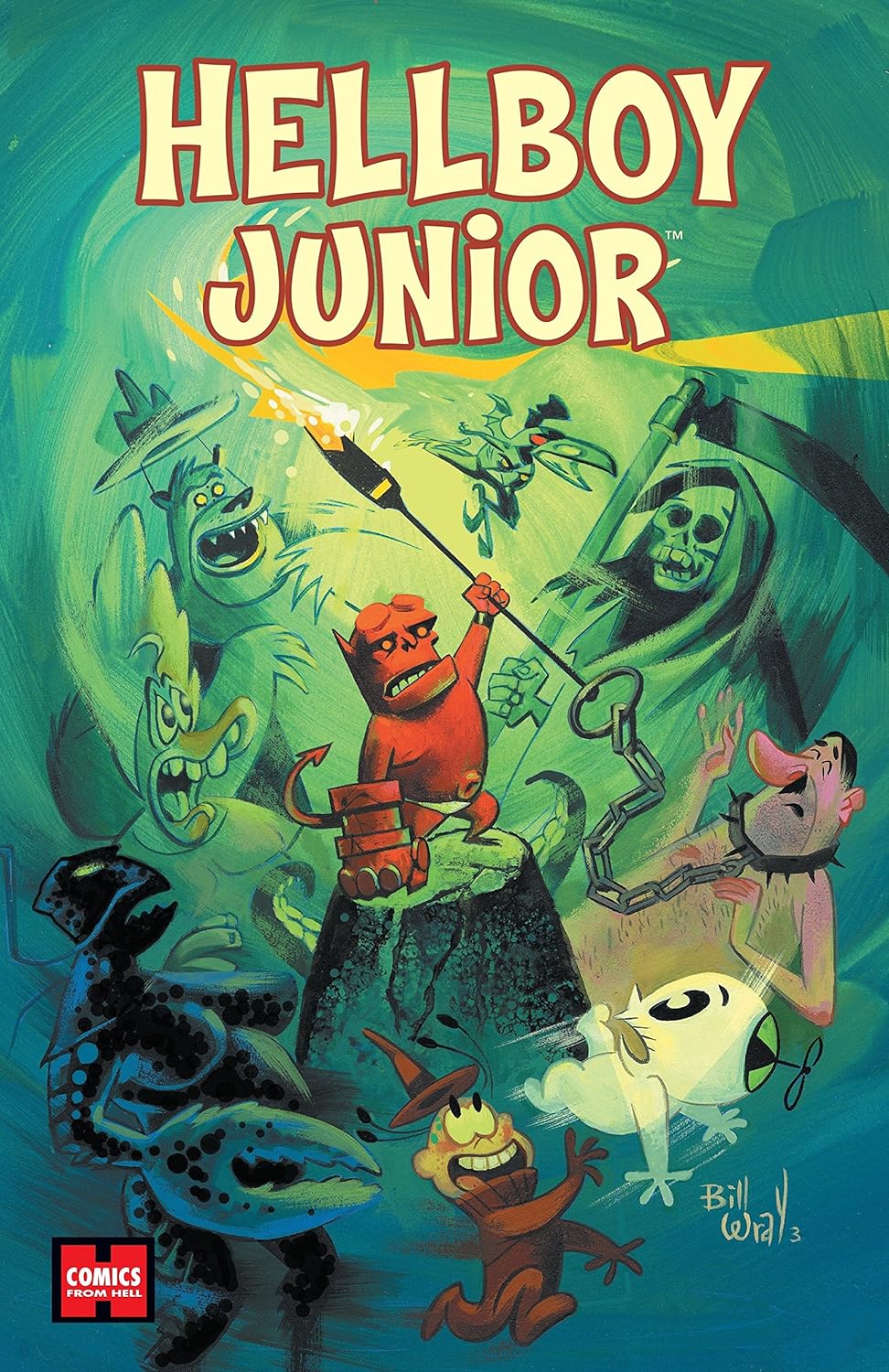
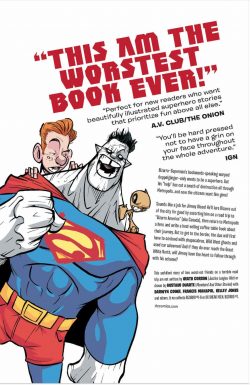
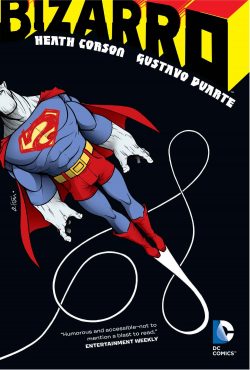
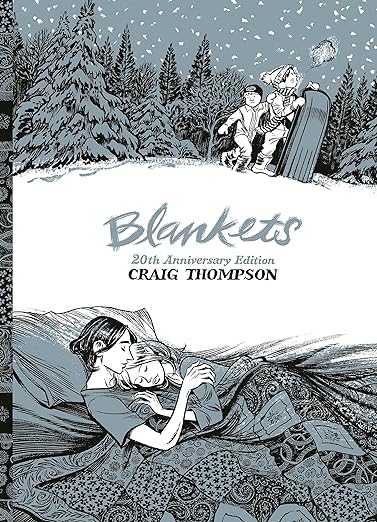
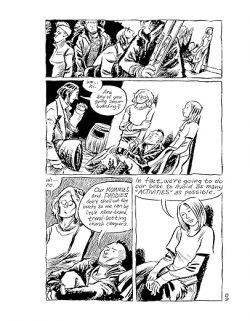 For such a weighty tome, Blankets is a remarkably quick and easy read, with Thompson’s imaginative and ingenious marriage of text and images carrying one along in the way only comics can. One of the most powerful and lovely tales of first love and faith lost, this book has lost none of its charm and seductive power over the decades. If you aren’t slavishly addicted to skimpily-clad incel-fodder or punch-in-the-face comics and have held on to the slightest shreds of your innate humanity, this is that rarest of beasts – a perfect story in pictures.
For such a weighty tome, Blankets is a remarkably quick and easy read, with Thompson’s imaginative and ingenious marriage of text and images carrying one along in the way only comics can. One of the most powerful and lovely tales of first love and faith lost, this book has lost none of its charm and seductive power over the decades. If you aren’t slavishly addicted to skimpily-clad incel-fodder or punch-in-the-face comics and have held on to the slightest shreds of your innate humanity, this is that rarest of beasts – a perfect story in pictures.